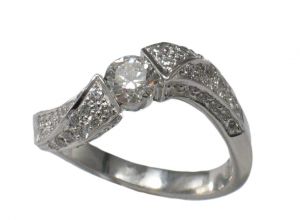Diamond Colour is the presence or absence of colour in white diamonds. A diamond that is perfectly transparent and clear is considered a perfect diamond. However, this is very rare. Most diamonds have some sort of colouration or hue that can either depreciate or increase its value. For example, a white diamond with some traces of yellow hue is discounted in price, while intense dark blue diamonds can be more expensive.
Diamonds are graded according to colourlessness. The more colourless it is, the more light is able to pass through it, giving it more sparkle and fire. Diamonds are graded using a letter scale of D to Z, with D considered very rare and the most colourless or ‘whitest’. Below is a basic guide to grading colorless diamonds and diamonds that are yellow or yellowish:
D-E-F
 Colourless
G-H-I-J
 Nearly colourless
K-L-M
 Faint Yellow
N-O-P-Q-R
 Very Light Yellow
S-T-U-V-W-X-Y-Z Light Yellow
Carat
Carat is the term used to describe weight of any gemstone, including diamonds. Large stones are very rare, so they are more valuable than smaller stones.
When buying a diamond ring, it is important to take the receiver’s character and lifestyle into consideration. If the bride-to-be has a very active lifestyle or career, wearing a huge rock may be a hassle for her. Get her a smaller sized diamond with a setting that protects the diamond from getting knocked around. If your bride-to-be has small fingers, small diamonds will look bigger.
Engagement rings are usually between 0.5 and 0.75 carat. Most cutters would purposely leave the diamond rough just to get a larger diamond and a higher selling price. So, if you’re buying a large stone, make sure that it also has a great cut. A small diamond with a good cut will have more sparkle and brilliance than a large diamond that is poorly cut.






















